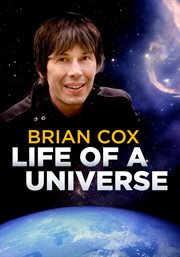Review by Publisher's Weekly Review
Where did it all come from? Readers who have pondered the question will find a simplified but informative answer in Bal's picture book introduction to the big bang and the life that evolved in its aftermath, up to the present day. Prior to the event there is a nothingness that turns into "a seed that will grow into everything else," which "blows itself up like a bubble." Van Doninck illustrates the formation of Earth through abstract images of celestial bodies; in its earliest form, the planet is a tumultuous region of angry seas and fiery volcanoes. Slowly, the seas fill with living creatures ("they all want the same thing: to eat and not be eaten"), some of which, "generation by generation," evolve onto the land. Readers won't gain a clear understanding of the vast expanse of time passing (the extinction of the dinosaurs occurs just a few pages before the emergence of humans). Regardless, Bal conveys the enormity of the material in a friendly and concise narrative. Ages 5--8. (Oct.)
(c) Copyright PWxyz, LLC. All rights reserved
Review by School Library Journal Review
K-Gr 3--Written in the present tense, this accessible book explains the big bang theory. Dramatic pictures work in tandem with the clear text to reenact the explosive origin of the universe. Earth's many transformations are shown with deeply saturated color illustrations from its fiery beginning, to the emergence of land and sea, to the gradual development of plant and animal life, to extreme climate variations, and, eventually, to the appearance of humans with their distinctive capacity to learn, invent, and communicate through reading and writing. Kids eager to know what happened to the dinosaurs will be satisfied by the spread depicting a giant rock crashing down and Bal's simple explanation: "Tough break for the dinosaurs--their time is up." Less convincing is the reference to Earth as a "big tangled web." It's a repeating phrase that lends a lyrical quality to the narrative but one that could have used a bit more explanation. VERDICT Overall this is a fine introduction to a complex topic and one that is suitable for children in the primary grades.--Gloria Koster, formerly at West School, New Canaan, CT
(c) Copyright Library Journals LLC, a wholly owned subsidiary of Media Source, Inc. No redistribution permitted.
Review by Kirkus Book Review
From nothing to "a big tangled web" of life, the origin of the universe and everything in it.Science journalist Bal pares the most commonly accepted models for the origin of the universe and development of life down to bare essentials, presenting them as accepted fact and gliding over some obvious questions. (Where did the stuff that fills the universe come from?) Nevertheless, this is an appealing addition to a small shelf of titles about cosmic beginnings for the very young. Unlike Marion Dane Bauer's The Stuff of Stars, illustrated by Ekua Holmes (2018), it stops with the accomplishments of humans as a group, ending with the moon landing rather than with the individual reader. Unlike Karen Fox's Older Than the Stars, illustrated by Nancy Davis (2010), there's no supplemental backmatter. Special to this version of the vast history are Van Doninck's sinuous illustrations, which explode with playful detail, swirls of color in the darkness of space, and surprising landscapes. One spread shows a wave of increasingly complex sea animals; another, the dinosaurs' world; and a third, the catastrophic arrival of an asteroid and the dark world that followed. Earth is repopulated with dark-furred apes learning to walk upright; lighter skinned cave artists; then farmers, herders, travelers, and finally astronauts of varied skin tones. First published in 2018 in the Netherlands, this was translated by the Canadian publisher for this English edition.A simple, effective introduction to some big ideas for curious young readers. (Informational picture book. 5-9) Copyright Kirkus Reviews, used with permission.
Copyright (c) Kirkus Reviews, used with permission.

